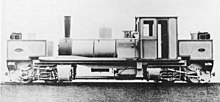Herbert William Garratt
Herbert William Garratt (born June 8, 1864 in London , † September 25, 1913 in Richmond , Surrey ) was an English locomotive designer and inventor of the Garratt locomotive .
Life
Garratt's professional career began in 1879 with an apprenticeship at the Bow Works of the North London Railway , run by John Carter Park . From 1882 he worked as an engineer in the shipyard of William Doxford & Sons in Sunderland . He then worked as a building supervisor for the engineers Sir Charles Fox and Alexander Meadows Rendel . In 1885 he applied for a patent for his first invention, an improved valve control for steam locomotives.
Garratt left Great Britain in 1889 and worked from then on for the South American Central Argentine Railway. From 1892 to 1900 he was locomotive superintendent of this company. In the following years he worked in Cuba (Havana Central), in Nigeria ( Lagos Government Railway ), Peru (Lima) and in Australia ( New South Wales Government Railways , NSWGR). In 1902 he was elected a member of the British Institution of Mechanical Engineers .
In 1906 he returned to Australia as a checking engineer for New South Wales Government Railways . One of his duties was inspecting the rail artillery of New South Wales . In this context, he also dealt with possible designs for gun mounts and discussed related issues with Beyer, Peacock & Co. , an important supplier to the NSWGR at the time.
Garratt realized that the same approach with which the problem of cornering and the limitation of the axle load could be solved in railway guns could also be used in locomotive construction. This idea led to his most important invention, the Garratt articulated locomotive , for which he applied for a patent in July 1907. Eleven months later, the patent was granted and Garratt began to search unsuccessfully for a locomotive manufacturer who wanted to implement his design. It was not until AH Hoy , the then General Manager of Beyer, Peacock & Co., that his idea caught on. Hoy handed the further processing to his future successor Rogerson.
Months of intensive development work followed, during which Beyer-Peacock and Garratt worked together to further develop the rough draft until it was ready for production. At the same time, Beyer-Peacock solicited customers for the new design. The first order for two narrow-gauge Garratt locomotives was placed by the Tasmanian Government Railway in 1909 . These locomotives, known as Class K , were compound machines with cylinders on the frame side. The next two locomotives, built in 1910 for the Darjeeling Railway , on the other hand, corresponded to Garratt's original design with simple steam expansion and a different cylinder arrangement.
In the following years Garratt worked on the further development of the articulated locomotive and patented oil firing systems for steam locomotives and, most recently, a spark arrester in the spring of 1913. Six months later, Garratt died at the age of 49.
Web links
| personal data | |
|---|---|
| SURNAME | Garratt, Herbert William |
| BRIEF DESCRIPTION | British engineer |
| DATE OF BIRTH | June 8, 1864 |
| PLACE OF BIRTH | London |
| DATE OF DEATH | September 25, 1913 |
| Place of death | Richmond, Surrey |
